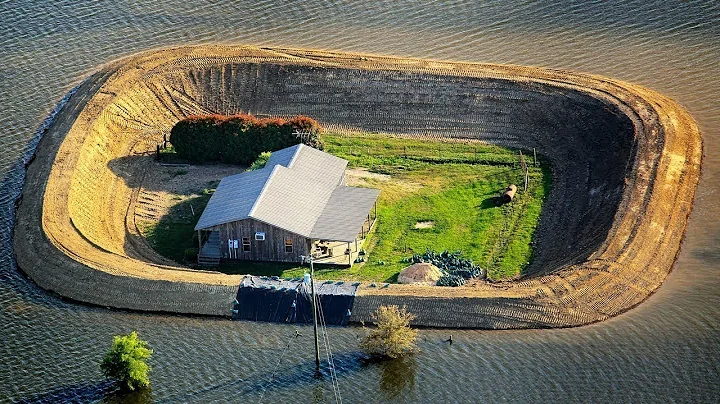The first day of the sixth month of the lunar calendar is called the "Little New Year" in some places, and it is also called the "New Wheat Festival" in some areas. There are many folk opinions about the first day of June. For example, the weather conditions on the first day of June can be used to predict whether there will be drought or floods in the second half of the year. What are the specific contents? Is the prediction accurate? In this article, the author will explain it in detail through proverbs, and everyone will have the answer after reading it.

- "If it is sunny on the first day of June, the cow grass will be used to build a pergola"
This proverb is interpreted literally. If it is sunny on the first day of June, then all the cow grass that year will be used to build a pergola. By extension, in the past, people basically fed cattle to cultivate the land, and the cattle's food was mainly grass. Grass was also relatively precious under the circumstances at that time, and they would not let the cattle eat it casually.
The pergola refers to the shed where cows enjoy the shade. When food is scarce, cow grass is used to build the pergola, which shows that the temperature is very high, and precious food is not hesitated to lower the temperature of the cowshed.
To put it another way, if the first day of June is sunny and the temperature is higher in the second half of the year, it means there is less rainfall and mostly sunny days, and drought is prone to occur in the fields.
- "The flow started on the first day of June, and the storm hit Mid-Autumn Festival on the 72nd"
Everyone has heard this proverb more often, in which "flow" refers to rain, and "storm" means heavy rain, which can also be said to be rainfall. More. Therefore, the meaning of this proverb is that if it rains on the first day of June, it will rain more in the future. From the first day of June to the Mid-Autumn Festival on August 15th, there will be 72 days of rain in between. Weather, the total interval between the two is only 75 days. If it rains for 72 days, it is obviously unlikely.
In fact, this proverb is an exaggeration to explain that if there is rainfall on the first day of June, there will be more rainfall in the second half of the year, and there is a risk of waterlogging.

- "If there is a shower at the beginning of June, the cattle herders will get gonorrhea"
The meaning of this proverb is also easy to understand. If it rains on the first day of June, even if it is a shower, the cattle herders will also get gonorrhea. There are two questions to understand. First, in the past, people mainly relied on cattle to cultivate the land. When people were young, they usually went to herd cattle. Even if they went to school, they would go to herd cattle after school.
Second, as to why gonorrhea occurs? It does not mean that it rained on the first day of June. What it means is that in the future, there will be more rain, but it did not rain when the cowherd boy went out to herd the cows, and it started to rain after he went out to herd the cows. , and then you need to rush home in time. If the frequency is too many, you will get gonorrhea.
Therefore, the meaning expressed by this proverb is similar to the second sentence. If it rains in early June, there will be relatively more rainfall in the second half of the year, increasing the chance of waterlogging.
From the above three farmer proverbs, we can draw a conclusion that if the first day of June is sunny, there will be more sunny days in the second half of the year, or there will be drought. On the contrary, if the first day of June is a rainy day, then there will be more rainy days in the second half of the year, or waterlogging may occur. This is why rural elders often say that the first day of June can predict droughts and floods.

From the current society, this statement has no scientific basis. Whether the weather is sunny or rainy is a natural phenomenon that occurs in the atmosphere and is related to many factors. As for drought or waterlogging, it doesn't matter much. Why did people in ancient times pay special attention to droughts and floods? In fact, it is related to agricultural planting technology.
In previous societies, there were no convenient irrigation and drainage measures. If there was no rainfall for a long time, the drought in the fields would be severe, and farmers would not be able to water the fields, and crop yields would not increase. In the same way, if there is a lot of rainfall that year and there is serious water accumulation in the fields, you can only watch the crops soak in the water. Regardless of drought or waterlogging, farmers have no particularly good solution. They can only accept the fact of reduced production, which is what everyone often calls "depending on the weather."

In today's society, when planting crops, the irrigation and drainage conditions in the fields are mature. If there is no rainfall for a long time and a drought occurs in the fields, farmers will irrigate and water in time to ensure that the crops receive moisture. Absorption.In the same way, if there is continuous rainfall and water accumulates in the fields, drainage work will be done to drain the water out of the fields as soon as possible to minimize the impact.
Therefore, people today are no longer interested in predictions of drought and floods on the first day of June. If they want to know the subsequent weather, they will check the weather forecast.

Today is the first day of June. Check today's weather forecast. There are many rainfall areas, including eastern Jilin, eastern Liaoning, eastern Shanxi, Beijing-Tianjin-Hebei, eastern Huanghuai, eastern Jianghuai, southern Southwest, western Sichuan Plateau southern, and northern Jiangnan. There will be moderate to heavy rain in parts of southwestern China, western South China, and southeastern Tibet. If we follow the above proverb, will waterlogging definitely occur in these areas in the second half of this year? The answer is obviously no.
In summary, according to popular proverbs, the first day of June is a sunny day, and there may be droughts in the second half of the year; the first day of June is rainy, and there may be waterlogging in the second half of the year. What do you think about this?
Today is the first day of June. It’s a rainy day here, but where are you?





















